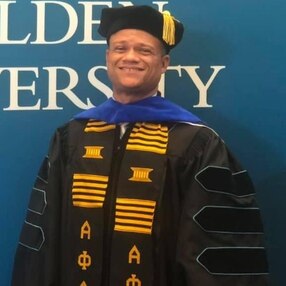STEM
Science, Technology, Engineering and Mathematics
 @HJBrent
@HJBrent
Howard Jehu Brent @HJBrent
Title: Instructional Coach and Peer Reviewer
Research Topic: Middle School Teachers’ Acceptance and Use of Edmodo to Sustain Networked Collaboration
Institution: Walden University
Committee Chair: Dr. Jennifer Courduff
Abstract: Although some middle school teachers integrate social media platforms into instruction, they generally use traditional and teacher-centered strategies rather than those that are innovative and student-centered. A gap exists in the literature on how teachers could use social media tools such as Edmodo to engage middle school students for innovative online collaboration. This qualitative case study explored the factors that contributed to the acceptance and use of Edmodo by middle school teachers in a Mid-Atlantic urban school district. Specifically, the research explored how teachers leveraged Edmodo to initiate and sustain networked collaboration with their students. The Unified Theory of Acceptance and Use of Technology 2 model, sociocultural development theory, and connectivism supported the conceptual framework. A criterion selection process was used to select 6 middle school teachers as participants. Data sources included 6 semi structured interviews, a focus group of 3 educational technology leaders, and school district documents. Data were analyzed using a priori codes based on the literature review and conceptual framework. Themes that emerged from the analysis included the following: acceptance and use of Edmodo as a communication platform, increased support of students’ organizational needs, enhancement of professional practice, initiation of networked collaboration, barriers and challenges in networked collaboration, and sustained networked collaboration. This research may contribute to positive social change by informing educational leaders and teachers on how to best leverage social media tools such as Edmodo in the middle school classroom to actively engage students in online collaboration, fostering a more student-centered learning environment.
Click the link below to download the full the study
Title: Instructional Coach and Peer Reviewer
Research Topic: Middle School Teachers’ Acceptance and Use of Edmodo to Sustain Networked Collaboration
Institution: Walden University
Committee Chair: Dr. Jennifer Courduff
Abstract: Although some middle school teachers integrate social media platforms into instruction, they generally use traditional and teacher-centered strategies rather than those that are innovative and student-centered. A gap exists in the literature on how teachers could use social media tools such as Edmodo to engage middle school students for innovative online collaboration. This qualitative case study explored the factors that contributed to the acceptance and use of Edmodo by middle school teachers in a Mid-Atlantic urban school district. Specifically, the research explored how teachers leveraged Edmodo to initiate and sustain networked collaboration with their students. The Unified Theory of Acceptance and Use of Technology 2 model, sociocultural development theory, and connectivism supported the conceptual framework. A criterion selection process was used to select 6 middle school teachers as participants. Data sources included 6 semi structured interviews, a focus group of 3 educational technology leaders, and school district documents. Data were analyzed using a priori codes based on the literature review and conceptual framework. Themes that emerged from the analysis included the following: acceptance and use of Edmodo as a communication platform, increased support of students’ organizational needs, enhancement of professional practice, initiation of networked collaboration, barriers and challenges in networked collaboration, and sustained networked collaboration. This research may contribute to positive social change by informing educational leaders and teachers on how to best leverage social media tools such as Edmodo in the middle school classroom to actively engage students in online collaboration, fostering a more student-centered learning environment.
Click the link below to download the full the study
| howard.pdf | |
| File Size: | 832 kb |
| File Type: | |
 @kshurina
@kshurina
Dr. Kristine Lynch Shurina
Title:Middle School English Teacher and Part-Time Professor of Literacy Education
Research Topic: E-Readers and Adolescent Engagement: A Formative Design Experiment
Institution: Rutgers, The State University of New Jersey
Committee Chair: Dr. Lesley Morrow
Abstract: As the use of e-readers becomes commonplace and more affordable, they will make their way into the hands of students. This research provides information about how the devices might be used as a tool to improve adolescent students‘ reading engagement and also helps to identify the struggles and pitfalls educators may face in implementing classroom use of e-readers.
This study investigated how the use of dedicated electronic reading devices could be implemented as an intervention in an eighth grade language arts classroom to improve students‘ reading engagement. Six students from an eighth grade, heterogeneous class in a sizeable suburban middle school in a large, regional district participated in formative design experiment (Reinking & Bradley, 2008). Quantitative and qualitative data were collected prior to and after implementation of the e-reader intervention to determine a baseline of the students‘ reading engagement and to assess any changes.
Additionally, qualitative data were collected throughout the intervention. Quantitative data were analyzed using a paired- samples t-test for the following measures: Reading Engagement Index (Guthrie et al., 2007), Adolescent Motivation to Read Profile (Pitcher et al., 2007), Metacognitive Awareness of Reading Strategies Inventory (Mokhtari& Reichard, 2002) and The Motivations for Reading Questionnaire (Wigfield & Guthrie, 1997). Qualitative data were coded for recurring themes derived from the following sources: classroom observation and field notes, teacher reflective journal, student and intervention specialist interviews and student written reflections.
Click the link below to download the full the study
Title:Middle School English Teacher and Part-Time Professor of Literacy Education
Research Topic: E-Readers and Adolescent Engagement: A Formative Design Experiment
Institution: Rutgers, The State University of New Jersey
Committee Chair: Dr. Lesley Morrow
Abstract: As the use of e-readers becomes commonplace and more affordable, they will make their way into the hands of students. This research provides information about how the devices might be used as a tool to improve adolescent students‘ reading engagement and also helps to identify the struggles and pitfalls educators may face in implementing classroom use of e-readers.
This study investigated how the use of dedicated electronic reading devices could be implemented as an intervention in an eighth grade language arts classroom to improve students‘ reading engagement. Six students from an eighth grade, heterogeneous class in a sizeable suburban middle school in a large, regional district participated in formative design experiment (Reinking & Bradley, 2008). Quantitative and qualitative data were collected prior to and after implementation of the e-reader intervention to determine a baseline of the students‘ reading engagement and to assess any changes.
Additionally, qualitative data were collected throughout the intervention. Quantitative data were analyzed using a paired- samples t-test for the following measures: Reading Engagement Index (Guthrie et al., 2007), Adolescent Motivation to Read Profile (Pitcher et al., 2007), Metacognitive Awareness of Reading Strategies Inventory (Mokhtari& Reichard, 2002) and The Motivations for Reading Questionnaire (Wigfield & Guthrie, 1997). Qualitative data were coded for recurring themes derived from the following sources: classroom observation and field notes, teacher reflective journal, student and intervention specialist interviews and student written reflections.
Click the link below to download the full the study
| rutgers-lib-40226_pdf-1.pdf | |
| File Size: | 4808 kb |
| File Type: | |